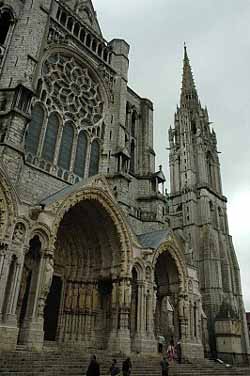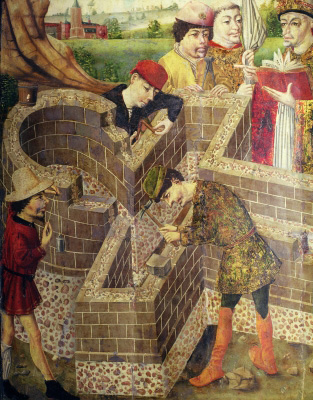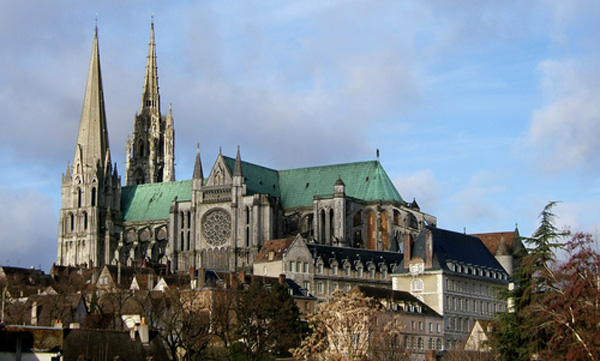 |
Stories & Legends
Hard Labor for God
Elaine Jordan
In 1134 a fire caused extensive damage to the Cathedral in Chartres. Thus began a complete rebuilding of that church, now dedicated to the Mother of God in the new Gothic style. One of the unusual features of Chartres Cathedral is the speed with which it was built. And this was due in great part to the movement that rose from the people, who came forth to perform the ‘hard labor for God.’ Australian architectural historian John James, who made a detailed study of the Cathedral, has estimated that there were about 300 men working on the site at any one time.

The lateral façade of Chartres Cathedral |
Who were these people? They were the young and old, the rich and poor, who applied their shoulders to the carts and wagons in order to convey to the site what was needed or to remove the rubble of the old. That initiative at Chartres triggered throughout the whole of France the people to undertake this task of hard labor for the glory and honor of God and the Blessed Virgin.
Describing this marvelous surge of enthusiasm and dedication among the people for building those grand Gothic Cathedrals, chronicler Robert de Torigny writes:
It happened for the first time at Chartres that people bent their backs to pull heavy carts full of stones, wood, sand, and other things necessary for the building of the Cathedral; its towers sprang up forthwith. Whoever has not seen this, will never see anything like it.
And not only in Chartres, but throughout the whole of France, in Normandy and many other places, people humbled themselves, did penance with sorrow and contrition, and forgave their enemies. One saw men and women, sinking up to their knees, drag carts through quagmires. One saw how they laid themselves open to strokes of the discipline, how everywhere miracles occurred, and how God was praised for their singing and rejoicing. (Chronique de Robert de Torigny, vol. 1, 50, 1872)
Archbishop Hugo of Rouen wrote to Bishop Thierry of Amiens how the people of Chartres began to humbly pull carts and wagons in order to help with the building of the church, and how their humility was rewarded with miracles. Many of the sick who were brought to the site were healed.
It was the people themselves to make it the rule that no one would be allowed to help unless he had been to confession and carried out the prescribed penance. Further, he must renounce anger and reconcile himself with his enemies. Then the group, thus united in the grace of God, would choose one of them to be their leader. Under his orders, in humility and silence they would pull the carts with their shoulders. (V. Mortet and P. Deschamps, Recueil de texts relatives a l’histoire de l’Architecture)
The Bishop of Rouen goes on:
These three things, namely, confession and penance, the forgiving of enemies, and humility with obedience, we impose as a condition on all those who come to us [in order to obtain our authorization for the ‘service of God with carts’]. If they fulfill these conditions, we receive them benevolently and give them our blessing. If they then give themselves over to the way with the right attitude, it often happens that their faith is rewarded with miracles, which God, in our church, works on the sick that they bring with them, so that they recover their health.
In the same year 1145, the Abbot Haimo of Saint-Pierre-sur-Dive wrote in a letter to his confreres in Tutbury:

The people from every order assisted in the building |
Whoever saw anywhere, whoever heard in previous generations of tyrants, princes, the powerful in this world, bloated with honors and riches, noblemen and noblewomen, bending their proud and haughty necks under the harness of carts, in order to bring to Christ's refuge, like draught animals, wine, corn, oil, lime, stones, wood and many other things necessary for the feeding of the building workers and the construction of the church?
It is remarkable to observe that, during this work, even when thousands of men and women are involved (for the materials to be moved are so massive, the vehicles so bulky, and the loads thereon so heavy), a complete silence reigns, and not a single word, not the slightest murmuring can be heard. If one had not seen it with one’s own eyes, it would be impossible to believe that such a great number were present. (M.J. Bulteau, Mongraphie de la Cathédrale de Chartres)
Abbot Haimo describes how the people, as soon as they reached the church, wanted to help build. They would erect a sort of field camp, and, during the whole night following their arrival, “the army of the Lord keep vigil and sing psalms and hymns.” He continues:
On each of the wagons candles and lamps are lit. The ill and the fragile are placed on the wagons. In order to bring them relief, the relics of the saints are carried past, and prayers are said for them. Then processions are held, with priests and clerics leading and the people following; with great fervor, and the goodness of the Lord and of His Sweet Mother are invoked, so that the sick may be healed.
The Mother of Mercy is readily touched; she has pity for the sufferings of those who pray to her, and mediates to heal the sick for whom prayers are said. Thereupon the sick and the frail jump down from the carts, throw away their crutches, and hurry to the altar to thank their Benefactress. The blind, seeing and filled with joy, walk with confidence. Those with dropsy are freed from their swellings and at the same time from their harmful thirst. ...
Such are the night vigils, the divine vigils, the camps of the Lord, the new piety, the new divinely inspired custom. There is nothing of the flesh therein; one sees nothing earthly, only the heavenly. ...
This holy custom began in Chartres and was confirmed amongst our people by countless virtues. Thereafter it spread throughout almost the whole of Normandy, and took a firm hold in all places that were consecrated to the Mother of Mercy (ibid.)

Chartres Cathedral today |

Selected and edited from Titus Burckhardt,
Chartres and the Birth of the Cathedral, World Wisdom Inc., 2010, pp. 60-63.
Posted May 21, 2011


Related Topics of Interest
 The Cathedral: Symbol of Paradise The Cathedral: Symbol of Paradise
 The Medievals Were Barbarians The Medievals Were Barbarians
 From Paradise St. Dominic Savio Teaches Us From Paradise St. Dominic Savio Teaches Us
 The Words of the Salve Regina The Words of the Salve Regina
 Simon de Montfort’s Good Habit Simon de Montfort’s Good Habit
 Fruits of the Devotion to Our Lady Fruits of the Devotion to Our Lady

Related Works of Interest
| |
|
Legends | Religious |
Home | Books | CDs | Search | Contact Us | Donate

© 2002-
Tradition in Action, Inc. All Rights Reserved
|
 |
|